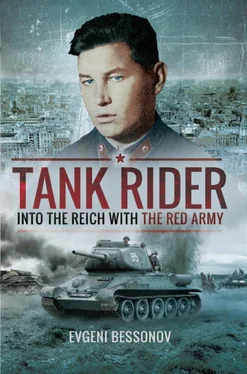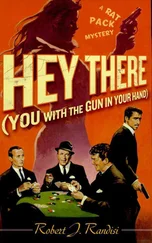The autumn was dry and warm, which allowed us to build dugouts for the incoming replacements and ourselves before the cold weather set in. We found metal barrels to make stoves and metal pipes for chimneys; however, we could not find doors for the dugouts, and we had to cover them with rain-proof capes. Officers and enlisted men started to arrive. The battalion commander in person distributed them among the companies. Lieutenant Kolosov arrived at our company as a machine-gun platoon leader. Young soldiers arrived at the company, born in 1925, just boys and middle-aged Azeri men, older than 30 or 35 years. They could not speak very good Russian and could hardly understand an order, but after some time started to understand orders without a translator. The Azeri men fought well and I had no complaints about them. Sergeant Major Vasili Blokhin left for the 3rd company, assistant platoon leader Sabaev was appointed Sergeant Major of the 2nd company on my recommendation. Mikhail Karpovich Bratchenko, machine-gun crew leader from the battalion’s machine-gun company, became the company’s Sergeant Major. We fought almost till the end of the war together with him.
An intensive training period started after the arrival of replacements. The personnel arrived from the replacement regiment; they were not from civil life and had some skills, but we had to teach them many things, especially firing the PPSh submachine-gun and the RPD (sometimes called DP) light machine-gun. We never had rifles in the battalion, just submachine-guns. After the cold weather set in, we were issued winter uniforms – valenki (felt boots), vatnik (padded jackets) and trousers, winter hats, woollen helmet liners and tarpaulin mittens with three fingers, warm underwear, woollen foot cloths. Officers were issued sweatshirts, fur vests and sheepskin coats. I did not take the sheepskin coat – the Germans knew that officers were dressed in sheepskin coats and tried to kill them first. Besides that, I was warm enough in a padded jacket. I did not wear the helmet liner and felt boots either. As ill luck would have it, the supply unit personnel could not get the winter hat for me and I had to wear a civilian hat of my size, of a reddish colour.
We had all kinds of training for the personnel. After the first snowfalls we even learnt to ski, although many did not know the first thing about skiing. I was reasonably demanding in my relationship with the soldiers, I tried to be just and did not try to find small faults, I treated every soldier as an individual. Most of the soldiers were 18 years old in 1943. They were not strong physically, mostly small and frail youngsters, so I tried to adjust the training programme to meet their physical and health capacity. Day and night we trained them for the future battles. We taught them things that they would need in combat at the front. We knitted the units together in tactical training, trying to cultivate a sense of comradeship. Soldiers had to adjust to each other; they had to understand how a platoon or company attacked in order to assist each other. That was the main thing. We had to build a core, to have a team, not a group of individual soldiers. We paid most attention to training at the platoon-company level. We had political classes as well – conversations and political information.
We considered that removing ‘tank fear’ and training soldiers to knock tanks out with hand grenades was a crucial point in the training. We did a ‘tank test-drive’ for that purpose. Soldiers would sit in trenches, while a T-34 would roll over the trenches once or twice. Boys were happy to see that it was not that scary and they were happy to see how brave they were. We had a little combat training with live ammo in attack and defence. I would often tell them about life at the front, sharing my combat experience. I went through the war all the way to Berlin with some soldiers from that replacement of 1943.
We all felt that our combat training was about to end. By then the soldiers had learnt skills, such as handling weapons, and grew stronger; I could see bravery and confidence in their eyes. Some of them were appointed squad leaders or even assistant platoon leaders. A short period of time passed – just two and a half months, and one could see the military bearing in them, the young boys had transformed into soldiers that I could lead into battle.
THE KAMENETS–PODOLSK OPERATION

Map to show the Kamenets-Podolsk offensive, July to August 1944.
In early January, 1944, following the order of Stavka, the 4th Tank Army was transferred to the Kiev area from the Bryansk forests. Our battalion and the tank regiment travelled to Bravary station near Kiev in one train. After this we crossed the Dnieper river by means of a temporary bridge, drove into Kiev’s outskirts and stayed in the buildings of a former technical college not far from Klavdievo station. That was in late January. We stayed there for a long time. I remember that the supply units fell behind us on the march and for some time we had awfully poor food – rye flour boiled in water without salt. We were constantly hungry. It was impossible to buy food for money, one could only exchange things for food, but we had nothing to offer for exchange. Officers had to put up with it, but soldiers were soldiers, they had to get good food – one could kick the bucket with that rye flour. Food was finally arranged by the efforts of the battalion commander and the zampolit ; after a week we started to receive decent rations. In mid-February 1944 we were again loaded on to a train, and even received 100 grams of vodka before getting on it (veterans usually refer to ‘grams’ of vodka – translator’s note) . That was the first and the last time that we received vodka – we never received it later. It was already late February when we got off the train at Polonnoe station. These rail journeys, both from the Bryansk forest area to Kiev and from Kiev to this station, took ages; especially long was the journey to Kiev, as it took about two weeks. The military trains were following each other at short distances, so we had to unload quickly, as the next train was about to arrive. The sky was cloudy; that is probably why the enemy’s air force was not present. We unloaded in darkness at Polonnoe station and marched on foot to Shepetovka, walking in dirt the whole night with short breaks for rest. We walked some 30 kilometres in the night and reached Shepetovka, where we went into houses and immediately fell asleep, even refusing to eat. We were so tired and exhausted that we did not even pay attention to the enemy’s artillery strikes that fell on the city.
At noon the battalion loaded on to Studebaker trucks and arrived in Slavuta. After a brief rest and meal we received an order to attack. That happened on 27 or 28 February, or perhaps even in early March. At first our battalion did not encounter any resistance from the enemy. The Germans were quickly abandoning their positions. In some places they would leave some outposts, but we would quickly defeat them. The terrain was open, without trees, cut by ravines and with a large number of settlements. That year spring came early to the Ukraine, and spring rain showers washed away the earth roads, making them hardly passable even for tanks, not to mention the wheeled vehicles. We had to walk on foot. That was where soldiers and officers suffered hellish pain – heavy mud stuck to our boots and we could barely drag our feet out of the sticky quagmire. Many soldiers carried machine-guns, boxes with ammo, mortars and mines. It was at least good that the battalion commander had ordered that the gas masks be left behind and appointed an officer who was to turn them over to the Brigade’s warehouse. Seemingly, a gas mask did not weigh much, but if one had to march on foot from dawn till dusk or even till midnight or next dawn, doing some 16 hours of marching, even a needle would seem heavy. Besides that, we could not always have a normal meal – the battalion kitchen was stuck in the dirt somewhere and could not catch up with us. It was impossible to find a dry spot during breaks, we had to sit down right in the dirt and immediately fell asleep for 10 or 15 minutes. Some soldiers even fell asleep while walking from exhaustion. One should not forget that most of the soldiers were just 18 years old.
Читать дальше














